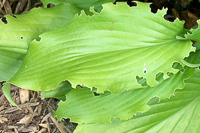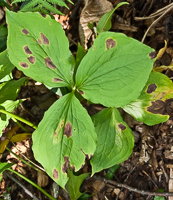
Fifty or sixty years
ago at the peak of the chemical revolution following
World War II, it was thought that all you had to do
was spray, spray, spray to rid yourself of any and
all of your ornamental plant problems. It seemed so
simple.
Unfortunately, there
is rarely, if ever a case where dealing with nature
is simple. Over time we found that there were plenty
of negative impacts to our spraying...some of which
nobody could have predicted at the time. The
environmental impacts were mind boggling at times.
Fortunately, the
trends have been changing, if too slowly at times,
and more environmentally sensitive approaches are
becoming more common. One of the pioneering changes
came with the development of a process called
Integrated Pest Management (IPM) which is sometimes
now called Integrated Plant Management.
 Originally,
this was aimed at farmers and orchardist and those
in the job of producing our crops. However, the
concepts in this process are easily adapted to the
home landscape.
Originally,
this was aimed at farmers and orchardist and those
in the job of producing our crops. However, the
concepts in this process are easily adapted to the
home landscape.
Essentially, IPM asks
you to truly identify your problem (and not just
guess about it), figure out how much damage you are
willing to accept (we don't need perfection), look
at the whole range of alternatives for achieving
your goal and then taking a look to see if what you
did really helped.
The following four
sections will help you to develop a thought process
for using the Integrated Pest/Plant Management
system in your backyard. Give it a try. Your
pocketbook, your landscape plants and your natural
environment will thank you.



